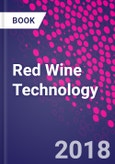Red Wine Technology is a solutions-based approach on the challenges associated with red wine production. It focuses on the technology and biotechnology of red wines, and is ideal for anyone who needs a quick reference on novel ways to increase and improve overall red wine production and innovation. The book provides emerging trends in modern enology, including molecular tools for wine quality and analysis. It includes sections on new ways of maceration extraction, alternative microorganisms for alcoholic fermentation, and malolactic fermentation. Recent studies and technological advancements to improve grape maturity and production are also presented, along with tactics to control PH level.
This book is an essential resource for wine producers, researchers, practitioners, technologists and students.
Please Note: This is an On Demand product, delivery may take up to 11 working days after payment has been received.
Table of Contents
1. Grape Maturity and Selection. Automatic Grape Selection2. Acidification and pH Control in Red Wines
3. Maceration and Fermentation. New Technologies to Increase Extraction
4. Use of Non-Saccharomyces Yeasts in Red Winemaking
5. Yeast Biotechnology for red winemaking
6. Malolactic Fermentation
7. Yeast-Bacteria Coinoculation
8. Molecular Tools to Analyze Microbial Populations in Red Wines
9. Barrel Ageing. Types of Wood
10. Emerging Technologies. Use of Chips. Microoxigenation
11. Ageing on Lees. Use of Non-Saccharomyces Yeasts. Accelerated AOL. Lees Impregnation
12. Evolution of proanthocyanidins during grape maturation, winemaking and aging process of red wines
13. Color evolution and stability
14. Polymeric pigments in red wines
15. Spoilage yeasts in red wines
16. Red Wine Clarification and Stabilization
17. Sensory analysis of red wines
18. Management of astringency in red wines
19. Aromatic compounds in red varieties
20. The instrumental analysis of aroma-active compounds for explaining the flavor of red wines
21. SO2 in wines: rational use and possible alternatives
22. Bottling and packaging
23. Red winemaking in cool climates
24. Red winemaking in cold regions with short maturity periods








